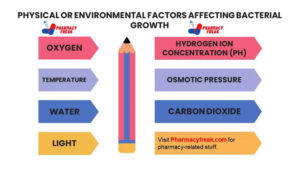Back to: MICROBIOLOGY 100 LEVEL
Welcome to class!
Hello, my brilliant learner! I’m so glad to see you again, ready to unlock more secrets about the tiny world of bacteria. Today, we will talk about the important conditions that affect bacterial growth—temperature, pH, osmotic pressure, and oxygen requirements. Just like you need the right room temperature, comfortable surroundings, and good food to feel your best, bacteria also need certain conditions to grow well. Understanding these factors helps us control bacteria in hospitals, farms, and even at home. Let’s see what these factors are all about!
Temperature, PH, Osmotic Pressure, Oxygen Requirements
Temperature
Bacteria are sensitive to temperature. Some grow best in the warm, humid climate of Nigeria, while others prefer cooler or hotter places. Scientists classify bacteria by the temperature range they like:

Psychrophiles: These bacteria love cold places like the fridge or icy rivers. They grow best below 20°C.
Mesophiles: Most bacteria, including many that cause diseases, grow best at moderate temperatures—around 30°C to 40°C. This includes the human body temperature (37°C).
Thermophiles: These bacteria thrive in hot environments like hot springs or cooked food, growing well above 45°C.
Knowing these helps in food storage and preventing spoilage or infection.
pH
The pH tells us how acidic or alkaline a substance is. Bacteria also have pH preferences:
Acidophiles: These love acidic environments, like fermented foods (think of ogi or sour milk).
Neutrophiles: Most bacteria prefer neutral pH around 7, similar to our blood and tissues.
Alkaliphiles: These bacteria thrive in alkaline or basic conditions, like soda lakes.
Changing the pH can stop bacteria from growing or kill them, which is why we use acidic or alkaline cleaners.
Osmotic Pressure
This is about the balance of water and salt around bacterial cells.
If there is too much salt outside (like in salted fish or dried meat), water leaves the bacteria, causing them to shrink and die. This is called plasmolysis.
If the environment has less salt, water flows into the bacteria, and they may burst.
Bacteria that survive in salty places like dried fish or fermented locust beans are called halophiles—salt lovers!
Oxygen Requirements
Bacteria differ in how they use oxygen:
Aerobes: Need oxygen to grow, like humans needing air.
Anaerobes: Don’t need oxygen and may even die if exposed to it.
Facultative anaerobes: Can grow with or without oxygen.
Microaerophiles: Need only a little oxygen, less than is in the air.
Aerotolerant anaerobes: Don’t use oxygen but can survive in its presence.
Understanding these helps in treating infections and managing bacteria in different environments.

Think of bacteria like guests at a party: some prefer cool rooms (psychrophiles), some like it warm and cosy (mesophiles), some love spicy salty food (halophiles), and some want fresh air to breathe (aerobes), while others are fine hiding in a dark room (anaerobes).
Summary
- Bacteria grow best at specific temperatures (cold, moderate, hot).
- They have preferred pH levels—acidic, neutral, or alkaline.
- Osmotic pressure affects bacterial survival based on salt and water balance.
- Different bacteria have varied oxygen requirements, from needing air to avoiding it.
Evaluation
- What temperature range do mesophiles prefer?
- How does pH affect bacterial growth?
- What happens to bacteria in a salty environment?
- Name a type of bacteria that does not need oxygen.
- Why is understanding oxygen requirements important in microbiology?
You’re doing wonderfully! Every lesson you master helps you understand how to keep yourself and others safe from harmful bacteria, while appreciating their role in nature. Afrilearn is proud of you, and I’m excited for us to keep going. See you next lesson, superstar!
